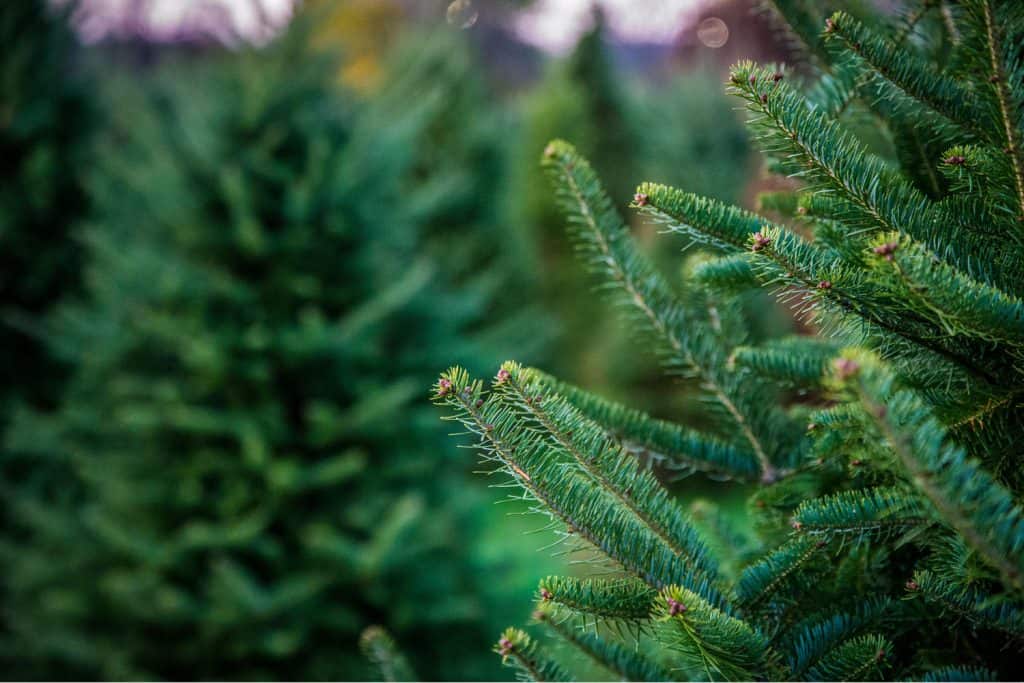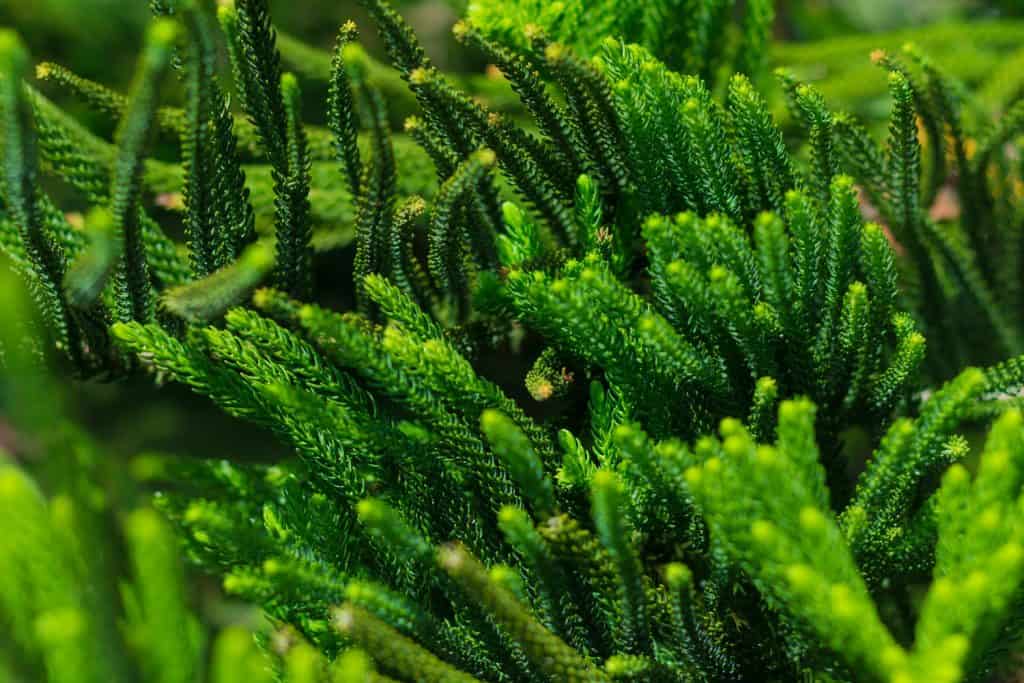Norfolk Island pine trees make four beautiful indoor and outdoor garden plants. These trees don't take much to grow and live for a very long time. But what do you do if your Island pine begins to die? Can you revive it? We've researched the answer questions, and we will discuss ways to help the dying tree.
Like other trees, Norfolk Island Pines are susceptible to environmental, pest, and fungal issues. However, for most growers, the environmental conditions often play the most significant part in the tree failing in health. This usually includes either over-watering or under-watering the plant as well as relocating the plant too quickly.
If you notice your Norfolk pine tree suddenly dropping leaves or pine needles in your home, the chances are that the plant is dying. However, depending on the current state of the plant, you may be able to revive it. Continue reading to learn how to revive your tree and ways to prevent it from dying.
![Healthy leaves of a Norfolk island pine tree, Why Is My Norfolk Island Pine Dying? [And What To Do About It]](https://gardentabs.com/wp-content/uploads/2021/11/Why-Is-My-Norfolk-Island-Pine-Dying-And-What-To-Do-About-It-683x1024.png)
What To Do If Your Norfolk Pine Tree Is Dying
Prune the tree
The first thing you'll want to do is to give the plant a cleanup. Cleaning up the plant will allow the pine tree to direct all of its new energy to build healthy new leaves and branches that will make it vibrant again. Let's look at how to do it.
Sanitize a pair of pruning shears and cut off any dead branches are leaves from the plant. If the plant has an infection, treat it with the proper antifungal or pesticide. Always sanitize your shears after cutting off an infected branch and before cutting an uninfected branch.

Never trim more than 30% of the tree's branches and leaves, as it may shock the plant and exacerbate its condition. If you need to trim more of the plant, do so in stages. For example, wait about a week or two before trimming the plant again.
Find pruning shears on Amazon.
Check the soil's moisture level
The next thing that you want to do is examine your watering frequency. How often do you water the plants? Is there a pool of water standing in the saucer after the water on session? How much water do you use in each session?
You should never leave the pine tree soaking in the water as it can very easily lead to root rot. Ensure that the pot has adequate drainage holes and that the water drains quickly from the pot and into the saucer.
Lastly, always drain the saucer after a watering session to prevent standing water from accumulating. Note that these plants prefer fast-draining acidic soil, so it's best to monitor the soil for the next few weeks after the pruning session. If the tree appears brown or yellow, it's likely overwatered.
Check the Humidity
A dying Norfolk island pine can also result from humidity levels that are too low or too high. On average, these trees prefer humidity levels around 50%. If you are unsure about the average humidity level in your home, it's best to purchase a hygrometer to monitor it at all times.
The humidity doesn't have to be 50% exactly, but it should be within 15 to 20% within this range. You may want to consider placing a humidifier in the room to assist with dryness if you live in a dry region--this can be especially beneficial during the winter season.
Find this hygrometer on Amazon.
Check the environment's temperature
This particular pine tree is frost-sensitive. Its ideal temperature range is anywhere from 40 degrees to 75 degrees Fahrenheit. The plant can begin to lose foliage when temperatures are below 40 degrees or over 95 degrees Fahrenheit.
Monitor its light access
These particular pine trees prefer full sun, though they can tolerate partial shade as well. If left in the shade, their green needles will turn dark, and they will turn completely brown if left in the shade for an extended period. It's always best to move any indoor pine to sunny locations in your home.
However, be sure to gradually acclimate the pine tree to the new environment to avoid shocking the plant. You'll also want to ensure that the tree is far from any air conditioner or heating vents or drafty areas in the home.
Check for Norfolk needle blight
Norfolk pines can also suffer from needle blight, which is typically the result of a tree being kept awake for too long. This fungal infection causes small spots on the tree's needles, and eventually, they'll turn brown and die if left untreated. At the beginning stages of a disease, a close inspection will reveal tiny black specks on the needles.
If you catch it early, you can still save the tree using a copper soap fungicide. You may need to repeat the antifungal remedy for a couple of weeks to rid the tree of the infection completely. Be sure to wear safety goggles, protective clothing, and gloves when treating the plant to avoid direct contact with antifungal chemicals.
Find this fungicide on Amazon.
Needle-Browning Pests
The Norfolk pine tree is also susceptible to several pests, the most common one being mites. Initially, you may not notice the pests, but they will become more apparent once the needles start turning brown or puttering. You can also take a branch and shake it over a white piece of writing paper to see if any mites fall off it.
These pests can be treated using your typical insecticidal soap or neem oil. If the plant is located indoors, you can also increase the relative humidity in your home to 50% to help mitigate mite issues.
Apply Fertilizer
In rare cases, a Norfolk pine tree will suffer from a lack of nutrients. This issue can easily be fixed by simply providing the tree with fertilizer. On average, an older pine tree will only need to be fertilized once every 3 to 4 months.
However, if the tree has recently been planted or is new, you should wait four to six months before adding fertilizer. Be sure to monitor the tree for the next few weeks after applying fertilizer. Also, never use more than the recommended amount of fertilizer, as it can damage the tree.
Check out this fertilizer on Amazon.
How do you tell if a Norfolk pine is dying?
The biggest way to tell if a Norfolk pine is dying is to inspect the tree's pine needles and branches. Here are a few telltale signs that the tree is sick.
The bark is peeling
A healthy Norfolk pine tree will retain its bark or at least most of it. When the tree becomes sick, the bark will begin to shed and turn light brown. So if you notice any large sections of tree bark missing from the pine, this could signify that it needs a closer inspection.
The needles are browning
The needles on pine trees don't turn colors throughout the year as the leaves on other trees do. The tree should maintain its distinct bright green pines through each season. If you notice that your tree's needles have begun to turn yellow or brown, it could indicate a pest or disease issue. This could also mean that the plant is overwatered or under-watered.
The needles are dropping too early
It's normal for pine needles to fall off during the fall season. However, if the needles start dropping during other parts of the year, such as in the spring or summer, this could indicate an issue with the tree's health as well.
The pinecones have spots
If you notice any small black spots on the trees pine cones, the tree may have a fungal disease. You may see this in combination with needles that have turned brown. The best thing to do is examine your tree closely to confirm the fungal presence and then apply a fungicide as needed.
How often should you water a Norfolk Island pine?

Norfolk Island pine should be watered about every one to two weeks. It's best to let the soil dry out a bit between each watering session. You may also want to change the watering frequency depending on how much sun the tree gets. The more sun the tree receives, the more moisture it will require.
Do Norfolk pines like to be misted?
Yes. It's perfectly fine to miss the plant once a week or more frequently if it receives a lot of sunlight or you notice the needles turning brown.
How long does a Norfolk pine live?
The Norfolk pine tree has an average lifespan of about 150 years.
Are Norfolk pines easy to care for?
Yes. These trees are relatively easy to care for. The main things they need to survive are sunlight, fast-draining soil, and adequate humidity levels.
Wrapping Things Up
If your Norfolk pine tree is dying, you may be able to revive it if you catch it in time. Remember to closely inspect the tree and examine your watering regime to determine the best route to bring it back to health.
To learn more, check out these other posts:






I had to repot my Norfolk Pine and now it not looking too good. It’s like the needles are dry and falling off. The soil is wet .
Help.
@Shirley Rush, I repotted my pine. It is with some brown. I use a water sprayer on cooler nights. On warmer days I have a spray bucket. I use the bucket from the top so the bucket of water gets in the container.
I bought my Norfolk Pine the end of October of 22. It was big, and bushy and beautiful, the branches soft.
Beginning of Dec. it had new growth on it, just beautiful. Now the middle of Jan. it’s a mess. The needles are like needles, pinches badly. None of it is brown, or yellow, still dark green, just dried up looking with the needles turning under, and if you bend a branch it snaps off. I water it, not too much, I mist it, it’s near a not too sunny window, and yet it’s dead. I don’t know what happened, to it. Would appreciate any help, but I’m sure it’s a a total loss now, and can’t get another one till this stinking weather breaks. 🙁
Thank you!
Nancy